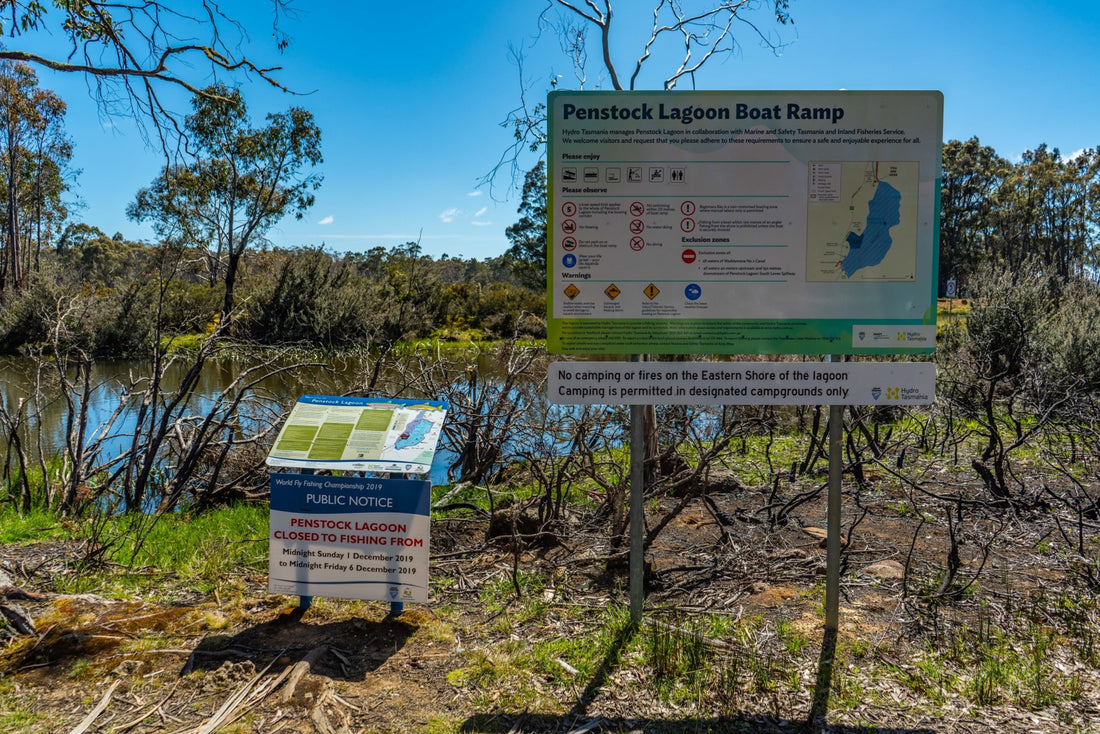
World Fly Fishing Championship 2019 in Tasmania: Session 4 on Penstock Lagoon
Share
Tasmania Session 4: Penstock Lagoon
My last lake session of the 2019 World Fly Fishing Championships was on Penstock Lagoon, which is another of Tasmania’s more famous stillwater fisheries. Penstock is most known for its prolific mayfly dun hatches, which create great dry fly fishing. It was the smallest and shallowest of the championship venues with much of the lagoon being less than three feet deep. This made the entire reservoir a productive littoral zone where weeds and insects are readily produced. It also makes it borderline too warm for trout in the late summer but that certainly wasn’t a problem while we were there.

Our guide max launching the boat during practice. If only the weather had been so settled during the championship.
Just as the day before, the draw paired Cory Scott of New Zealand and I in the boat with Cory in control for the first half of the session. The funny thing is that Pat Weiss was paired with a Kiwi angler the day before on Penstock as well, so we were both working from more or less the same information.

The boat dock before the wind picked up at the start of the session. They imported these sweet little loch style boats from the UK for the championship.
While Penstock was the most sheltered of the lake venues for the championship, the wind certainly still dominated proceedings there. All the local talk before the championship was about “the duns” hatching on Penstock. There were occasional spurts of activity during the three previous sessions, but the wind blew them immediately off the water and made controlling a floating line nymph rig difficult for the fish eating nymphs underneath. So once again most of the fish were caught pulling buggers on intermediate or type 3 lines.
I started the session with the same flies as Little Pine Lagoon the day before. I also started with a type 3 line but ended up changing it to an intermediate by the midpoint of the session. I figured it would be best to silhouette the flies above the fish in the windy turbid water. Because the conditions were fairly similar on all three venues my strategy was to make controlled casts and medium ranges and mix up my retrieves to find if there were any that worked better. I mixed in basic steady 12” strips, roly poly retrieves, quick short strips, steady scissor strips, and variations of all of these with pauses. And I always made sure to lift my rod tip and hang my flies just under the surface at the end of each retrieve.

The boat dock a few minutes before we loaded the boats and started the session. The wind must have been told it was about time.
Cory had the controller start our first drift in the area between the dam and the buoys (see map below). The bulk of the boats crammed into the area out from the dam because the trees provided the largest wind break in this area which also meant there was more clear water.
Similar to our first area on Little Pine the day before, our drifts started shallow near the bank and progressed quartering out into the lagoon. After we had gone 100-200 yards and were beyond the color change that signaled a slight drop off, we would reset the drift in shallow being careful to back track our drift and then move down the shore. This kept us from motoring over any of the water we would cover on our next drift.

On our second drift I had a nice brown eat on the hang on my first cast. It took the gold and olive bugger on my top dropper from just under the surface and jumped several times before coming to the net.
We progressively zig-zag drifted our way toward the buoys (see map) on the next several drifts. On one of these drifts I had another brown (almost identical to the first) take my point fly during the retrieve while we were nearing the slight dropoff beyond the buoys. This area was where my teammate Josh had caught quite a few rainbows on the first day, so I felt like we needed to focus on it for a while. Unfortunately, several boats came in behind us after I caught both fish so we couldn’t recycle through the area
We continued down the bank, but it took another couple of drifts before I had another fish flash on my flies at the surface but not take. Cory hadn’t had any fish yet, so he pulled the plug on our drifts and decided to move to the other side of the lake near a couple of isolated beds of strap weed where our teammates had moved some fish at the end of their session the day before. I’ll admit I was not happy with this move since I was still getting interest from fish. I looked at him a bit incredulously, but I wasn’t in charge of the boat and it was his call. It ended up being the winning move for us so I’m certainly glad he followed through.
Only one other boat was in the general vicinity when we moved. We started our first drift about 100 yards out from the strap weed. Our controller did a nice job of positioning the boat and adjusting the drogue so that we drifted just to the right side of the first weed bed.
When we got even with the first weed bed I hooked up with a big rainbow. It immediately took off making four or five jumps forcing my heart was in my throat and I expected it to come off at any second. The fish then turned and headed back upwind behind the boat. It stayed there for a long time and had several close encounters with the drogue but eventually I got it around the boat and into the net. It ended up being an impressive and obese 537 mm (just over 21”) and was the largest fish I landed during the championships.
We continued drifting toward the next strap weed bed out into the lake. They were only a few hundred yards apart but in the length of drift the turbidity of the water worsened drastically as a result of waves churning the bottom. We almost stopped the drift before we reached the second weed bed. Thankfully we didn’t because I hooked my next fish even with the strap weed. It was another large rainbow but thankfully it didn’t nearly give me a coronary like the previous fish.
We decided to continue the drift until we reached the far shore. Our guide Max had told us during practice that large browns often patrolled the shoreline. We didn’t find any though and circled back around to drift the weed beds again. This time our controller positioned the boat so that we drifted through the center of it. As we reached the down wind side of the weeds Cory hooked his first fish which was another rainbow. A minute later I hooked my fifth, which ended up being my last in the session and was also another rainbow. No other fish came on that drift near the far weed beds.
We circled around one last time, but two boats had seen us catch the previous fish and had started drifting over the same area. We started feeling crowded and it was time for a move. I was in control of the boat by this point. I planned to go back by the buoys or the boat dock but as we motored up lake, I saw that almost all of the boats had vacated the area near the dam. I decided to take a shot on the clearer calmer water there in the hope that the fish would have rested enough from all the boats which had been there previously.
The wind was much calmer near the dam in the lee of the trees, but it was swirly and made straight drifts impossible. There were a few duns hatching when we arrived, and Cory switched to a floater with some nymphs. Shortly there after he broke off a fish. He then landed another.
Given Cory’s flurry of activity, it was obvious I needed to make a change. I switched to a floating line with three mayfly nymphs. During my switch Cory landed one more fish. We only had about 15 minutes left in the session at this point. We had reached the far side of the lake opposite the dam and the wind and waves were serious there. We made one last move back to the dam into a crowd of boats that had returned. Unfortunately, neither one of us hooked another fish, which left Cory with three and me with five.
Given the windy conditions and the lack of dun hatch for most of the session, it had been slow for the other anglers as well. When we met at the tent to get food before getting back on the bus, I found out that I had won the session, which is always a great feeling at a world championship.
The session for our team was better than the day prior but still mixed. Pat Weiss finished 12th place on the Meander River, Josh Graffam finished 3rd place on Woods Lake, Michael Bradley finished 7th on the Mersey River, and Lance Egan finished 13th on Little Pine Lagoon. This session elevated us from 10th place to 6th place as a team. I had climbed up to 24th place and Josh Graffam had a shot at a medal going into the last session in 4th place.

Howard Croston, aka "Mr. Happy" with a Penstock brown caught while I shared the boat with him the week after the championship. Howard ended became the World Champion in Tasmania so he had a lot to be happy about.
